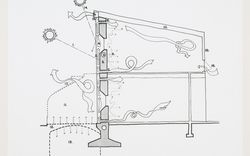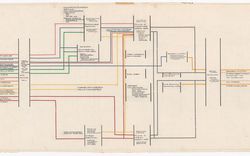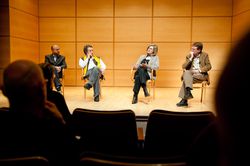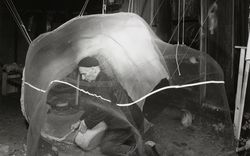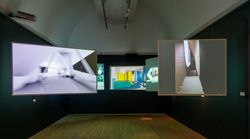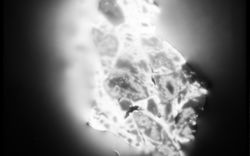Sous-série
AP178.S1.1988.PR07.SS9
Description:
This project series documents the restoration of the Grandes Armazéns do Chiado building in Lisbon, Portugal. While the records were held in the office’s archives this project was assigned the number 58/80 N4. The office assigned the dates 1988-1998 for this project. The Grandes Armazéns do Chiado was part of Bloco C and identified as building 4 in Siza's reconstruction plan. The site of the Grandes Armazéns served several different functions in its history, including a hotel, a palace, and a convent, before becoming a department store in 1894. In the 1920s, a hotel was created at the top floors. After the destructive fire of 1988, the new owners of the building were interested in using the totality of the building for a shopping mall and restaurants. On the other hand, Siza's proposal included the expansion of the hotel in the building to introduce more public activity in the area after the regular work and shopping hours. Several programs were proposed to the owners of the building, and it was decided in 1996 that the hotel space would be reduced to the two top floors to have more room for the shopping center. The new division included 41 hotel rooms and 41 stores. The interior of the shopping mall was designed by Eduardo Souto Moura. Drawings include studies, working drawings, mechanical drawings, and structural drawings. Textual material includes project documentation, studies, meeting reports, and correspondence. Photographic material includes photographs of the building before the fire, ruins, model, and construction work. Documentation for this project can also be found in subseries AP178.S1.1988.PR07.SS1 and AP178.S1.1988.PR07.SS7 of this project series.
1988-2000
Recuperação do Edifício dos Grandes Armazéns, Bloco C, Reconstrução do Chiado [Restoration of Grandes Armazéns do Chiado building, Block C, Reconstruction of the Chiado] Lisbon, Portugal (1988-1998)
Actions:
AP178.S1.1988.PR07.SS9
Description:
This project series documents the restoration of the Grandes Armazéns do Chiado building in Lisbon, Portugal. While the records were held in the office’s archives this project was assigned the number 58/80 N4. The office assigned the dates 1988-1998 for this project. The Grandes Armazéns do Chiado was part of Bloco C and identified as building 4 in Siza's reconstruction plan. The site of the Grandes Armazéns served several different functions in its history, including a hotel, a palace, and a convent, before becoming a department store in 1894. In the 1920s, a hotel was created at the top floors. After the destructive fire of 1988, the new owners of the building were interested in using the totality of the building for a shopping mall and restaurants. On the other hand, Siza's proposal included the expansion of the hotel in the building to introduce more public activity in the area after the regular work and shopping hours. Several programs were proposed to the owners of the building, and it was decided in 1996 that the hotel space would be reduced to the two top floors to have more room for the shopping center. The new division included 41 hotel rooms and 41 stores. The interior of the shopping mall was designed by Eduardo Souto Moura. Drawings include studies, working drawings, mechanical drawings, and structural drawings. Textual material includes project documentation, studies, meeting reports, and correspondence. Photographic material includes photographs of the building before the fire, ruins, model, and construction work. Documentation for this project can also be found in subseries AP178.S1.1988.PR07.SS1 and AP178.S1.1988.PR07.SS7 of this project series.
Project
1988-2000
articles
articles
La pratique muséologique, telle qu’elle a émergé au cours du XXe siècle, est sans contredit profondément remaniée. Les changements radicaux dans le statut de l’objet, de la culture, des diverses disciplines ou de l’information et de l’éducation entraînent une inévitable transformation du rôle et des compétences du conservateur. Un intérêt renouvelé pour la pratique(...)
Théâtre Paul-Desmarais
11 novembre 2010 au 13 novembre 2010
Le CCA dans un champ muséologique en expansion
Actions:
Description:
La pratique muséologique, telle qu’elle a émergé au cours du XXe siècle, est sans contredit profondément remaniée. Les changements radicaux dans le statut de l’objet, de la culture, des diverses disciplines ou de l’information et de l’éducation entraînent une inévitable transformation du rôle et des compétences du conservateur. Un intérêt renouvelé pour la pratique(...)
Théâtre Paul-Desmarais
articles
Jia Gu, Hannah Rose Feniak, Matthey Critchley, Aldo Rossi, Frederick Kiesler, Eero Saarinen
20 juillet 2020
Archéologie du numérique : complexité et convention représente le troisième et dernier volet d’une série d’expositions liées à la constitution d’archives numériques au CCA. Le programme Archéologie du numérique comprend vingt-cinq projets pour lesquels les documents numériques constituent des éléments essentiels à la compréhension du processus de conception(...)
11 mai 2016 au 16 octobre 2016
Archéologie du numérique : complexité et convention
Actions:
Description:
Archéologie du numérique : complexité et convention représente le troisième et dernier volet d’une série d’expositions liées à la constitution d’archives numériques au CCA. Le programme Archéologie du numérique comprend vingt-cinq projets pour lesquels les documents numériques constituent des éléments essentiels à la compréhension du processus de conception(...)
Série(s)
AP195.S3
Description:
Series 3: Construction working files and related correspondence, 1996 – 2015, contains CAD files and related textual records documenting the evolution of the Phaeno Science Centre project over time, particularly during the construction and post-construction phases. Formats represented include chiefly CAD drawings (plotter files, AutoCAD drawings, DXF), as well as text documents (Microsoft Word, Microsoft Excel, PDF, plain text) and images (JPEG, TIFF). There is also a significant amount of email correspondence (MSG, MBOX). The bulk of the materials dates from 2000 – 2005. The materials in this series chiefly consist of project working files by year from 2002 to 2015 (non-inclusive). These directories primarily consist of plotter files and other construction drawings in CAD formats, both sent and received by ZHA. Alongside the drawings, there is also often a significant body of textual material, including email correspondence, memoranda, meeting minutes, translations, legal documentation, and other administrative material. Taken altogether, the working files provide insight into the construction of the Phaeno Science Centre as it evolved over time. In addition to the working files, there are also a number of other files arranged topically. This includes material for construction permit applications, invoices to the client and contractors, construction schedules and pricing, materials related to consultants, and additional detail drawings. Notably, this series also contains the email archives of Sara Klomps, a project architect for the Phaeno Science Centre from the early 2000s through at least 2015. These materials reflect her work on the project, particularly communication with the client and consultants, as well as the arc of her career at ZHA, where she became associate director in 2014.
1996 - 2015
Construction working files and related correspondence
Actions:
AP195.S3
Description:
Series 3: Construction working files and related correspondence, 1996 – 2015, contains CAD files and related textual records documenting the evolution of the Phaeno Science Centre project over time, particularly during the construction and post-construction phases. Formats represented include chiefly CAD drawings (plotter files, AutoCAD drawings, DXF), as well as text documents (Microsoft Word, Microsoft Excel, PDF, plain text) and images (JPEG, TIFF). There is also a significant amount of email correspondence (MSG, MBOX). The bulk of the materials dates from 2000 – 2005. The materials in this series chiefly consist of project working files by year from 2002 to 2015 (non-inclusive). These directories primarily consist of plotter files and other construction drawings in CAD formats, both sent and received by ZHA. Alongside the drawings, there is also often a significant body of textual material, including email correspondence, memoranda, meeting minutes, translations, legal documentation, and other administrative material. Taken altogether, the working files provide insight into the construction of the Phaeno Science Centre as it evolved over time. In addition to the working files, there are also a number of other files arranged topically. This includes material for construction permit applications, invoices to the client and contractors, construction schedules and pricing, materials related to consultants, and additional detail drawings. Notably, this series also contains the email archives of Sara Klomps, a project architect for the Phaeno Science Centre from the early 2000s through at least 2015. These materials reflect her work on the project, particularly communication with the client and consultants, as well as the arc of her career at ZHA, where she became associate director in 2014.
Series
1996 - 2015
Sous-série
AP178.S1.2002.PR05.SS1
Description:
This project subseries documents the Parque de Vidago Complexo Termal e Hotel Palace in Vidago, Portugal. While the records were held in the office’s archives this project was assigned the number 49/00. The office assigned the date 2002 to this project. The project consisted of major renovations to update and modernize the Vidago Palace Hotel, originally opened in 1910, and the addition of a new thermal spa. Architects José Pedro Lopes Vieira and Diogo Rosa Lã were responsible for the interior decoration of the Palace Hotel, while Siza designed the Spa. The full or partial demolition of some parts of the hotel and nearby buildings was necessary to maintain the original character of the resort. In contrast to the historic hotel, the new spa was contemporary and minimalist with marble interiors. It included pools, Turkish baths, treatment and relaxation rooms, a gym, bars and meditation area. This project subseries is documented through drawings, photographic materials, study models and textual records dating from 2002-2012. These materials primarily document the spa but documentation for the surrounding site, Palace Hotel, Fonte Salus (spring), gatehouse and Serralves exhibition space is also included. The drawings are largely reprographic copies of printed CAD drawings and include sketches, studies, plans, details, sections, elevations, demolition drawings and mechanical, electrical and structural drawings. The textual records include correspondence, meeting minutes, studies, building programs, furniture and spa equipment documentation, budgets and contracts. A large amount of documentation on various electrical, structural and mechanical systems is also included. The photographic materials are mostly printed digital photos showing buildings across the site, pre and post construction work and reference images. There are also a number of photos, postcards and brochures showing historical images of the hotel.
2002-2012
Parque de Vidago, Complexo Termal e Hotel Palace [Vidago Palace Hotel and Spa], Vidago, Portugal (2002)
Actions:
AP178.S1.2002.PR05.SS1
Description:
This project subseries documents the Parque de Vidago Complexo Termal e Hotel Palace in Vidago, Portugal. While the records were held in the office’s archives this project was assigned the number 49/00. The office assigned the date 2002 to this project. The project consisted of major renovations to update and modernize the Vidago Palace Hotel, originally opened in 1910, and the addition of a new thermal spa. Architects José Pedro Lopes Vieira and Diogo Rosa Lã were responsible for the interior decoration of the Palace Hotel, while Siza designed the Spa. The full or partial demolition of some parts of the hotel and nearby buildings was necessary to maintain the original character of the resort. In contrast to the historic hotel, the new spa was contemporary and minimalist with marble interiors. It included pools, Turkish baths, treatment and relaxation rooms, a gym, bars and meditation area. This project subseries is documented through drawings, photographic materials, study models and textual records dating from 2002-2012. These materials primarily document the spa but documentation for the surrounding site, Palace Hotel, Fonte Salus (spring), gatehouse and Serralves exhibition space is also included. The drawings are largely reprographic copies of printed CAD drawings and include sketches, studies, plans, details, sections, elevations, demolition drawings and mechanical, electrical and structural drawings. The textual records include correspondence, meeting minutes, studies, building programs, furniture and spa equipment documentation, budgets and contracts. A large amount of documentation on various electrical, structural and mechanical systems is also included. The photographic materials are mostly printed digital photos showing buildings across the site, pre and post construction work and reference images. There are also a number of photos, postcards and brochures showing historical images of the hotel.
Project
2002-2012
recherche
Thème : Le phénomène de changements de paradigmes en architecture depuis l’Antiquité : Oliver Botar, École d’art, Université du Manitoba, Winnipeg, Canada Sujet : On Biocentrism and Modernism in Weimar German Architecture and Art Fabrizio Nevola, School of Architecture, Syracuse University Florence, Italie Sujet : Siena, 1450-1520: From ‘Medieval’ to ‘Renaissance’(...)
septembre 2000 au août 2001
Chercheurs en résidence 2000-2001
Actions:
Description:
Thème : Le phénomène de changements de paradigmes en architecture depuis l’Antiquité : Oliver Botar, École d’art, Université du Manitoba, Winnipeg, Canada Sujet : On Biocentrism and Modernism in Weimar German Architecture and Art Fabrizio Nevola, School of Architecture, Syracuse University Florence, Italie Sujet : Siena, 1450-1520: From ‘Medieval’ to ‘Renaissance’(...)
recherche
septembre 2000 au
août 2001
articles
Témoin matériel
La vie des documents, la photographie en tant que projet, Stefano Graziani et Bas Princen, Susanne Kriemann, conversation, histoire orale, paysages radioactifs
11 mars 2024
Témoin matériel
Susanne Kriemann raconte comment la photographie enregistre les paysages radioactifs
Actions:
